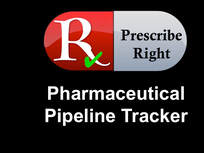|
Regulatory Update
The FDA accepted the BLA for Sanofi’s isatuximab for multiple myeloma and set a PDUFA date for the end of April 2020. The drug has multiple mechanisms of action including direct induction of apoptosis, antibody-dependent cellular cytotoxicity, antibody-dependent cellular phagocytosis, and complement-dependent cytotoxicity. The FDA accepted the NDA for Janssen and ViiV’s once monthly cabotegravir and rilpivirine injection and set a PDUFA date for the end of 2019. Horizon submitted a BLA for teprotumumab for Graves ophthalmopathy in July 2019. Announced Research Updates ITC announced that in a 6-week, 381 patient, Phase III trial, lumateperone 42 mg reduced the Montgomery-Asberg Depression Rating Scale (MADRS) score by 16.7 points compared to a 12.1 reduction with placebo in patients with Bipolar disorder, who were experiencing a major depressive episode. ITC announced that in a 6-week, 381 patient, Phase III trial, neither lumateperone 42 or 28 mg improved the MADRS score compared to placebo in patients with Bipolar disorder, who were experiencing a major depressive episode. Amgen and Novartis discontinued two trials evaluating umibecestat in the prevention of Alzheimer's disease in pre-symptomatic patients with a genetic risk to develop the disease after an interim analysis found worsening cognitive function. A review by ICER of treatments for Duchenne’s found limited data that a slight increase in levels of dystrophin with eteplirsen and golodirsen provides a clinically significant effect. ICER concluded that if golodirsen is priced like eteplirsen, it would not meet cost benefit standards. At the current price, if either drug were able to restore perfect health in DMD patients for an additional 40 years of life, the drugs would far exceed cost-effectiveness thresholds of $100,000 and $150,000 per Quality-Adjusted Life Year (QALY) gained or $100,000 and $150,000 per Life Year Gained (LYG). Published Research Updates ICER released a review of AR101 and Viaskin Peanut in July 2019. ICER expressed concern regarding the lack of long-term data for safety and effectiveness, desensitization did not eliminate the need to be cautious with peanut exposure and increase in allergic reaction requiring epinephrine seen during clinical trials. The panel also did not find evidence to support AR101 and Viaskin Peanut to have a benefit over avoidance of peanuts or non-commercialized oral immunotherapy. In a pharmacoeconomic analysis, ICER estimated a benchmark fair-market price of $4,800-7,200 per year for AR101 and $3,000-$4,500 per year for Viaskin Peanut. In a 48-week, 294 patient, Phase II/III trial, treatment with masitinib 4.5 mg/kg/day plus riluzole 100 mg/day slowed the increase in ALSFRS-R by 27% compared to riluzole monotherapy in patients with amyotrophic lateral sclerosis. Masitinib in a dose of 4.5 mg/kg/day added to riluzole did not differ from placebo in progression of ALSFRS-R. In a 1,072 patient, Phase III trial, 19.6% of patients treated with rimegepant were pain-free and 37.6% were free of their most bothersome symptoms at two hours compared to 12% and 25.2% that received placebo in patient with migraine. In the 72-week, 419 patient, Phase II, SYNERGY trial, opicinumab failed to show improvement in disability compared to placebo in patients with relapsing multiple sclerosis. In the 12-week, 1,629 patient, Phase III, SELECT-COMPARE trial, more patients treated with upadacitinib/methotrexate improved compared to methotrexate monotherapy achieving ACR20 (71% vs 36%) and DAS28CRP<2.6 (29% vs 6%) in rheumatoid arthritis patients. At 26 weeks more, patients in the SELECT-COMPARE trial that received upadacitinib achieved low disease activity or remission compared to placebo or adalimumab. In three 13-week Phase III trial with a total of 3,864 patients, mirogabalin did not improve the weekly average daily worst pain score compared to placebo in patients with fibromyalgia. In a 176 patient, Phase II, open-label trial, 16% of patients treated with NBTXR3 added to radiotherapy achieved a pathological complete response compared to 8% with radiotherapy alone in patients with locally advanced soft-tissue sarcoma. In a 7-year, 3,084 patient, Pharmacy III trial, GSK’s malarial vaccine the incidence of severe malaria infections were 0.004 cases per person-years (PPY) with the four-dose regimen and 0.007 with the three-dose regime compared to 0.009 in the control group in children 5-7. Among children age 3-5 the incidence of severe malaria infections were 0.007 cases per person-years (PPY) with the four-dose regimen and 0.007 with the three-dose regime compared to 0.011 in the control group. Vaccine efficacy against severe malaria in both age groups did not appear to improve overall efficacy. Comments are closed.
|
Stay informed, subscribe to the
Prescribe Right Pharmaceutical Pipeline Tracker Latest Tweets from Prescribe Right
Archives
July 2023
|
Services |
Company |
Support |
© COPYRIGHT 2015. ALL RIGHTS RESERVED.
|


 RSS Feed
RSS Feed